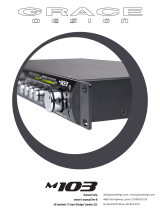
page 5
m
501
m501 CONNECTIONS
MICROPHONE INPuT
The mic input is located on the back of your 500 series rack. This connector should be wired pin 2 posi-
tive, pin 3 negative and pin 1 ground (check with your rack manufacturer’s documentation for connec-
tor details). 48V phantom power, if used, is supplied on pins 2 and 3.
BALANCED XLR OuTPuT
Balanced XLR line output connector are located on the back of your 500 series rack. This connector
should be wired pin 2 positive, pin 3 negative and pin 1 ground (check with your rack manufacturer’s
documentation for connector details).
INSTRuMENT AND LINE INPuT
Instrument and line level signal connections are made using the ¼” TRS jack on the front panel of the
m501 module. This connector is balanced with the tip positive, ring negative and sleeve ground.
When a plug is inserted into the instrument input, a sealed gold contact relay switches the preamplier
input source from the rear panel mic input connector to the front panel TRS jack. The input impedance
of the instrument input is 2.5M Ohm unbalanced and 5M Ohm balanced, which is ideal for inserting
high impedance sources such as guitars with passive pickups, as well as any instrument with a high level
output. Please note that the gain range of the preamplier when using the instrument input is –10dB to
+55dB.
Using the instrument input with an unbalanced source is simple. When a mono ¼” jack is used, the
sleeve will automatically ground the inverting input (ring) when plugged in.
INSTALLING THE m501 IN A 500 SERIES RACK
Open your m501 box. The module is in a bag under the plastic ‘korvu’ retain-1.
ing sheet, which you should be careful not to cut. Simply fold down the outer
cardboard aps, then the under side aps, which will loosen the module from
under the plastic sheet.
Turn o and unplug your 500 series rack frame. Inspect the card slot you intend 2.
you use to make sure that it is clean and free of any debris.
Before removing your m501 from its anti-static bag, discharge any static electric-3.
ity buildup you may have by touching your 500 series rack.
Pull your m501 module out of its anti-static bag and carefully slide it into place 4.
in the designated opening. Sight down the back of the module (use a ashlight
if necessary) and ensure the card edge connector is aligned to seat into the card
slot of the frame.
Firmly and evenly push the m501 module into place until its is positively seated 5.
in the card slot.
Use the 2 supplied #4-40 hex head screws and 3/32” hex wrench to mount the 6.
m501 front panel to the 500 series rack. These screws have a pretty tight t;
please be careful not to cross thread.
Plug your 500 series rack back into the AC source and power up your rack. Your 7.
m501 will automatically power up with your 500 series rack.























